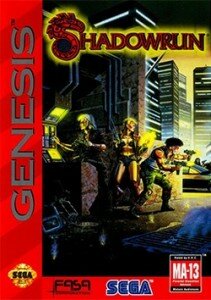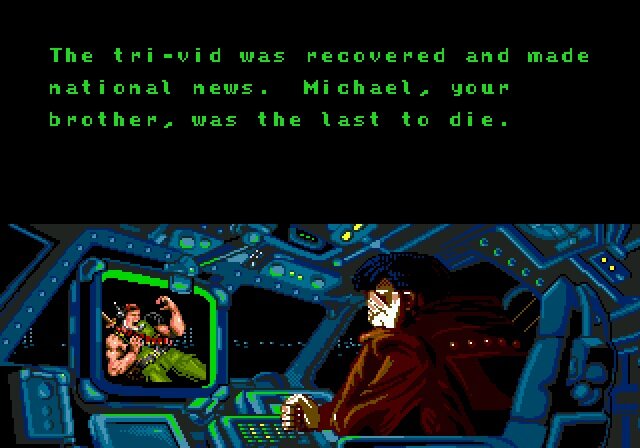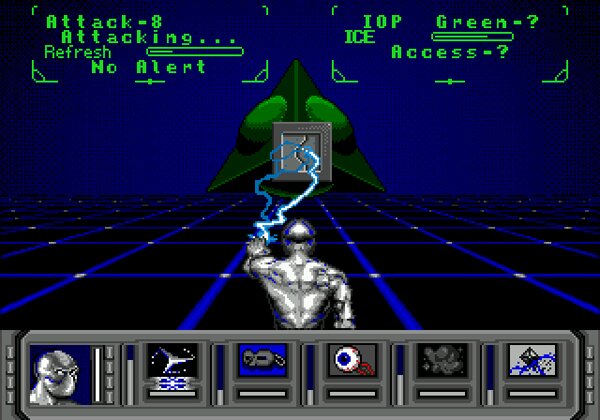Retro Fix:- Shadowrun (Mega Drive / Genesis Version)
 Seeing as the ‘Shadowrun Returns’ Kickstarter is well on it’s way (having passed the $1m mark at the time of writing) and with mentions to it popping in several places of the videogame press, I though that now would be an appropiate to look back on the history of Shadowrun and why is it so popular.
Seeing as the ‘Shadowrun Returns’ Kickstarter is well on it’s way (having passed the $1m mark at the time of writing) and with mentions to it popping in several places of the videogame press, I though that now would be an appropiate to look back on the history of Shadowrun and why is it so popular.
Shadowrun started as a pen & paper roleplaying game back in 1989, and right off the printer, it was something special. It mixed what was by then (and even now) two very different settings, a grim gritty cyberpunk world with magic and Tolkien-esque fantasy races (and by magic I don’t mean psionics or other quasi-mystical powers like the force of biotics, I mean literal magic in the traditional fantasy sense).
The basic premise of the game goes somewhat like this; in 2011 (yep, last year) the Mayan long Calendar ended (in the 1980s it was though to be 2011, more recent calculations place it in 2012) and magic burst once more into the world, bringing the end of the fifth world. Human parents gave birth to Elves and Dwarfs because of their long dormant genes, Dragons soared over some cities of the world, and teenagers suddenly “goblinized” turning into Orks and Trolls.
The world was throw in chaos, people with old mystical traditions found out that their rituals and fetishes carried real power, the USA and Canada were split asunder when natives used this new-found power to reclaim their lands from the white man and, after destroying what was left of the old countries, merged into the UCAS (with the CAS splitting in the south). The situation in other parts of the world was equally mad.
Megacorporations, which had been growing in power since the early 2000s became so powerful that they claimed extraterritoriality, and started fielding armies like any other nation.
As the situation stabilized, the world of the shadows emerged. With conflict brewing on multiple sides, corporations, nations, mystical groups and powerful creatures like Dragons needed disposable assets, agents without ties but capable enough to carry their goals, and thus Shadowrunners were born. Runners are the people living inside the cracks of this crazy world, ex-soldiers, gangsters, rouge mages or adrenaline junkies that offer their services to “Mr Jonhson” (ALL employers in the shadows are named Mr Johnson) and do their dirty work.
As you can probably see not only the world but subject matter was odd and exotic for it’s time, Shadowrun heroes are morally ambiguous but their actions are a reflection of their world, and many are only in the business as a means to survive.
Shadowrun has been a productive franchise, with multiple books, a card game, a miniature game and (at the date of writing this) four videogames, (one of which is Shadowrun in-name-only, at least setting wise).
The best remembered games are the ones named simply “Shadowrun” of which there were three, one for the SNES, another for the Genesis/ Mega Drive and another for the Mega CD, all of which are really different from one another. I’m going to talk about the Genesis one, for me the best of the three (although this is arguable) if only because is the one that it’s closer to the pen & paper game, and because it actually is a very primitive version of a modern sandbox game… something that I really find intriguing as a gamer.
The game starts with a videofeed captured by the cyber eyes of a runner team in dangerous territory, the team is ambushed in an obvious set-up, and our protagonist, Joshua, sees how his brother is killed in action. Joshua then takes a flight to Seattle, where his brother worked as a runner, intent on discovering why he was killed and possibly taking revenge on the matter. The game then drops you in Seattle, more specifically in Redmon, where Joshua tries to grab his brothers stuff in search for clues, but the coffin hotel manager will have none of that, and demands that Joshua pays for his brother’s standing tab… thus the adventure begins.
Joshua can start as either a Street Samurai, a Decker, or a Gator Shaman, this starting archetypes determine your starting stats and skills, but from that point onward, you’re free to enhance your character in whatever direction you want (with the sole exception of magic, either you start as the shaman or you’ll never be able to learn magic). You play the game on an top-down somewhat flat perspective, moving Joshua around town and getting into bars, clubs and different other places. By walking around the street you might trigger random encounters with gangs, Lone Star officers (rent-a-cops) and other NPCs. Whenever you’re in a conversation, you usually have a primitive dialogue tree that you move through using the A, B and C buttons, and through contact with different characters you could get some extra secondary quests, contacts or equipment.
The game is completely free-form, a sandbox if you will, the main plot is there, and you can follow it at your leisure (though it’s not recommended you do till you beef up your character a lot) but there are plenty of “Mr Johnson” around to give you random “runs” (quests) that will reward you with nu-yens (cash) and karma (experience) to empower yourself further.
At it’s most basic, the game is something of a primitive GTA; you basically run around Seattle doing sidequests and having encounters, improving your arsenal and hiring other runners, untill you’re either bored or ready to take on the main quest. There are no vehicles (which strikes you as odd in a place like Shadowrun’s Seattle, but it’s because tech limitations) and locations look kinda the same, but it’s quite a rich and engrossing world.
Runs you get from Johnsons are random, but generally picked from a list of possibilities, theft of corporate resources, “extractions” (which are basically prearranged “kidnappings” with people wanting to change jobs from Corp to Corp), Sabotage and Matrix runs.
Matrix runs are special because they are a completely separate game, in Matrix runs you jump into the Tron-like dimension that is the Matrix, and try to sabotage or more often steal information from a systems nodes. These nodes appear as obstacles in your way, some only block your transit, while others attack you whith several degrees of lethality. While on the matrix, you can equip programs as defensive and offensive skills or items, and they have levels like your skills, though your skill in computers determines much of their effectiveness. Matrix runs probably ended up being the most common for players, as they are by far the most profitable.
The plot itself is nothing to write home about, and it get’s a tad confusing towards the end, but it’s acceptable, since it’s basically an excuse for setting up the game.
While primitive nowadays, the Mega Drive Shadowrun is a gem of a game that deserves some more time in the light, and it’s definitely a must play for younger gamers interested on seeing a predecessor to the modern GTAs and Saint Row games, and hopefully, they will be in for a treat, as Shadowrun Returns is looking promising!
That’s enough of my old man musings for now… have fun in the Shadows chums… and remember, Shoot Straight. Conserve Ammo. And Never Cut a Deal With A Dragon. (Unless that Dragon is Lofwyr, he doesn’t take no for an answer)
- Jose Luis Pérez Zapata










